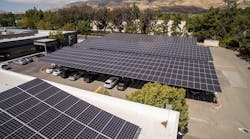Net Zero Energy as Competitive Advantage to Produce More in US?
Energy usage is under strict surveillance as many states push hard to lower their carbon footprint. California has been particularly aggressive in these goals and in 2017, the California Public Utilities Commission introduced the California Energy Efficiency Strategic Plan which sets specific goals for the development of zero net energy buildings.
An energy-efficient building is defined as one where the actual annual consumed energy is less than or equal to the on-site renewable generated energy.
The strategic plan calls for specific actions which include:
- 50% of commercial buildings will be retrofit to ZNE by 2030
- All new commercial construction will be ZNE by 2030
- 50% of new major renovations of state buildings will be ZNE by 2025
Complying with these standards will cause manufacturers to dig in even deeper when evaluating energy usage. One of the largest benefits of this energy reduction effort is the accompanying reduction in the overall cost of doing business.
The question then arises as to whether this cost reduction could be one of the keys to keeping more manufacturing in the U.S?
Derek Hansen, CEO of Mynt Systems who recently completed the first retrofitted zero net energy building in Silicon Valley, thinks so.
“In order to compete with China and other countries, we need to compete on the operating costs of our plants,” Hansen explains. “One of the best ways to do that is to save on energy. And while we become more energy efficient, we are improving our environment.”
Mynt Systems retrofitted Sonic Manufacturing which is the largest electronic manufacturing services factory in Silicon Valley. Located in Fremont, it is the first in the Bay Area to be retrofitted for zero net energy.
Sonic, which leases its building, wanted to reduce its carbon footprint. And at the same time, the building owner wanted to reduce its overall footprint. For the building owner, the goal was to keep Sonic as a tenant and to increase the property’s value. As the goals of both parties dovetailed, Mynt Systems devised solutions that simultaneously met the needs of both parties.
The timing of the retrofit offered a further incentive as Sonic could become grandfathered onto the utility’s time of use rate structure which was being closed off to large commercial customers in early 2017.
To reduce total energy use Sonic looked at reducing the lighting and cooling loads. By installing a 750kW rooftop solar system and a 273kW carport solar system, the energy usage would be offset.
The annual kWh saving is 1,574,651 translating into $308,040 saving the first year. These solar systems will produce 1.6 million kWh of clean power per year and over $8 million in avoided utility costs, over the next 25 years. And if that is translated into gallons of gasoline
Furthermore, the ROI on the investment of $3.5 million for the systems was just under five years.
The speed of the ROI was matched by the speed of the city of Freemont in helping Sonic get the permits necessary. Projects like this can take anywhere from six months to two years, but the city of Fremont is “intentionally setting the pace,” said Hansen in order to help the manufacturing community. He gives the city a lot of credit for the success of the program.
The model of manufacturing companies working with building owners to reduce energy use and provide benefits to both is something that Hansen sees happening more.
“It’s a good model to encourage companies to remain where they are since the building owner shares the costs of necessary upgrades.” And in this case, the building owner received a $1.1 mill tax credit and $6 million additional value to the property.
There are other benefits to become a green manufacturing facility, says Hansen. “The supply chain has become greener and in fact, some companies will only buy products that are manufactured at green facilities.”
Hansen notes that the paradigm of doing the right thing is a cost to companies is now being replaced with doing the right thing actually increases the bottom line.
Creating a green manufacturing facility is an all-around win says Hansen since it achieves triple bottom line results --people, profit and planet.




